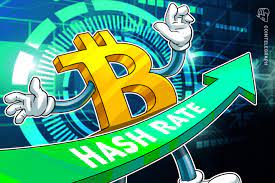Miners must compete using their machines to solve a difficult mathematical problem.
“Hashrate” refers to the combined computational power used to mine and process transactions on a Proof-of-Work blockchain, such as Bitcoin and Ethereum (before the 2.0 upgrade).
A “hash” is a fixed-length alphanumeric code representing words, messages, and data of any length. Crypto projects use various hashing algorithms to create different types of hash code – think of them like random word generators where each algorithm is a different system for generating random words.
For instance, the hash for “coindesk” using the hashing algorithm that Bitcoin uses, SHA256, is f2429204b339475a3d94dd5450f5ebb3c80130a85fbb91d62768741a3b34a6b6
Before new transactional data can be added to the next block in the chain, miners must compete using their machines to guess a number. More specifically, miners are trying to produce a hash lower than or equal to the numeric value of the ‘target’ hash by changing a single value called a ‘nonce’. Each time the nonce is changed, an entirely new hash is created. This is effectively like a lottery ticket system, where each new hash is a unique ticket with its own set of numbers.
For example, if we take “coindesk” and change the first letter to make “foindesk,” we get this completely different hash = 5a12a9af1b5794bf6855c15944339d41ff713665e415b5434b8c9f081c61b66a
Because each hash created is random and impossible to predict, it can take millions of guesses – or hashes – before the target is met and a miner wins the right to fill the next block and add it to the blockchain. Each time that happens, a block reward of newly minted coins is given to the successful miner along with any fee payments attached to the transactions they store in the new block.
Adding a block to the blockchain “confirms” all the transactions stored within that block. Every time a new block is added on top of earlier blocks, those earlier transactions are reconfirmed repeatedly, becoming more and more impossible to change.
For most Proof-of-Work (PoW) blockchains, the block reward – a predetermined amount of free coins given to a miner each time a new block is mined – undergoes a programmed halving to incrementally reduce the total supply throughout a coin’s mining lifespan. For Bitcoin, block rewards are cut in half every 210,000 blocks or approximately every four years. As of 2021, miners receive 6.25 Bitcoins each time they mine a new block. The next Bitcoin halving is expected to occur in 2024 and will see BTC block rewards drop to 3.125 bitcoins per block. Dash is another mineable cryptocurrency that reduces its block rewards by 7.14% for every 210,240 blocks, while Litecoin halves its rewards for every 840,000 blocks.
What’s the importance of hashrate?
The hashrate is an important metric for assessing the strength of a blockchain network – more specifically, its security. The more machines honest miners dedicate to discovering the next block, the higher the hashrate rises and the harder it becomes for malicious agents to disrupt the network.
A 51% attack, for example, is when a single individual or group of attackers purchases or rents enough mining equipment to control over 50% of a blockchain’s hashrate. Because blockchains are trustless and abide by a rule known as the “longest chain rule,” a person or group that controls most of the hashrate could, in theory, block or reorganize transactions and even reverse their payments. This would create double-spending issues, which, in turn, would completely undermine the integrity of the underlying blockchain.
A fall in hashrate means reducing the cost to perform a 51% attack, making the network more vulnerable.
Hashrate FAQs
What is Bitcoin’s current hashrate?
This article was published at 89 EH/s, which stands for exahashes per second. 1 exahash = 1 quintillion hashes.
That means that miners are currently computing 89 quintillion hashes every second.
What is mining difficulty?
Mining “difficulty” is how difficult it is for miners to produce a hash below the target. It’s achieved by reducing the numeric value of the hashed block header.
Bitcoin’s difficulty, for example, is measured using an internal score that begins at 1 (the easiest level) and grows or shrinks exponentially depending on how many miners are competing on the network. That score automatically adjusts every 2, 016 blocks – approximately every two weeks. Right now, that number is around 13,912,524,048,946.
Blocks are targeted to be found by miners every 10 minutes. So, the difficulty increases if miners solve blocks and find bitcoins more often than every 10 minutes on average. The difficulty decreases if miners find bitcoins less often than every 10 minutes on average.
The more miners there are online, the more hashrate is produced, meaning that more “guesses” are generated. The more guesses there are, the more likely the correct hash will be discovered quickly. Since blockchains are generally designed to add blocks (and release new coins) at a steady, predictable rate, the difficulty is programmed to adjust automatically after a set number of blocks to keep that rate consistent.
How is hashrate calculated?
There’s no way to know the exact Bitcoin hashrate, though it can be estimated. Hashrate is traditionally estimated based on public data about Bitcoin, including the difficulty metric described above.
Though this traditional estimation method is in the right ballpark, this methodology has long been criticized as inaccurate. Cryptocurrency exchange Kraken proposed another way of estimating the hashrate, using statistics to show with 95% confidence that the hashrate lies in some range.

More and more miners have entered the fray in Bitcoin’s short history, pushing the hash rate up.
The most likely reason for new miners joining the highly competitive space is because of Bitcoin’s extreme price potential. Increased demand for bitcoin (a scarce asset) has pushed the price above $33,000 per coin at press time, attracting more operators who see mining as an opportunity to make significant returns.
Increasing the number of miners pushes Bitcoin’s difficulty up, which increases the hash rate.












